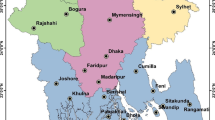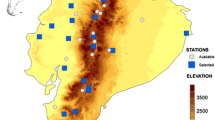Abstract
This chapter shows the influence of the North Atlantic Oscillation (NAO) on droughts in the entire Mediterranean region between 1901 and 2006. The analysis has been based on identification of positive and negative NAO winters and also detection of the anomalies of drought severity by means of the Standardized Precipitation Evapotranspiration Index (SPEI). The analysis is focussed on the winter NAO. Nevertheless, given that the SPEI drought indicator can be obtained at different time-scales, the study shows how the effects of the winter NAO on droughts are propagated for the following months when long time scales are considered. In general, during the positive phases, the negative SPEI averages are recorded in Southern Europe (the Iberian Peninsula, Italy and the Balkans), areas of Turkey and northwest Africa. On the contrary, the SPEI averages are found positive in northeast Africa. The opposite configuration, but with some differences in the spatial patterns and the magnitude of the SPEI averages, is found during the negative NAO years. The findings of this study should be of great applicability in terms of developing early warning systems. The established relationships between NAO phases and drought indices seem appropriate for drought prediction over large areas of the Mediterranean basin.
Access this chapter
Tax calculation will be finalised at checkout
Purchases are for personal use only
Similar content being viewed by others
References
Abramopoulos F, Rosenzweig C, Choudhury B (1988) Improved ground hydrology calculations for global climate models (GCMs): soil water movement and evapotranspiration. J Clim 1:921–941
Austin RB, Cantero-Martínez C, Arrúe JL, Playán E, Cano-Marcellán P (1998) Yield-rainfall relationships in cereal cropping systems in the Ebro river valley of Spain. Eur J Agron 8:239–248
Beguería S, Vicente-Serrano SM, Angulo M (2010) A multi-scalar global drought data set: the SPEIbase: a new gridded product for the analysis of drought variability and impacts. Bull Am Meteorol Soc 91:1351–1354
Breshears DD, Cobb NS, Rich PM et al (2005) Regional vegetation die-off in response to global-change-type drought. PNAS 102:15144–15148
Briffa KR, Jones PD, Hulme M (1994) Summer moisture variability across Europe, 1892–1991: an analysis based on the Palmer drought severity index. Int J Climatol 14:475–506
Burton I, Kates RW, White GF (1978) The environment as hazard. Oxford University Press, New York, 240 pp
Cai W, Cowan T (2008) Evidence of impacts from rising temperature on inflows to the Murray-darling basin. Geophys Res Lett 35:L07701. doi:10.1029/2008GL033390
Changnon SA, Easterling WE (1989) Measuring drought impacts: the Illinois case. Water Resour Bull 25:27–42
Ciais Ph, Reichstein M, Viovy N et al (2005) Europe-wide reduction in primary productivity caused by the heat and drought in 2003. Nature 437:529–533
Colombaroli D, Marchetto A, Tinner W (2007) Long-term interactions between Mediterranean climate, vegetation and fire regime at Lago di Massaciuccoli (Tuscany, Italy). J Ecol 95:755–770
Elfatih A, Eltahir B, Yeh PJF (1999) On the asymmetric response of aquifer water level to floods and droughts in Illinois. Water Resour Res 35:1199–1217
Gerten D, Rost S, von Bloh W, Lucht W (2008) Causes of change in 20th century global river discharge. Geophys Res Lett 35:L20405. doi:10.1029/2008GL035258
Gouveia C, Trigo RM, DaCamara CC, Libonati R, Pereira JMC (2008) The North Atlantic Oscillation and European vegetation dynamics. Int J Climatol 28:1835–1847
Guttman NB (1998) Comparing the Palmer drought index and the Standardized Precipitation Index. J Am Water Resour Assoc 34:113–121
Helsel DR, Hirsch RM (1992) Statistical methods in water resources. Elsevier, New York, 522 pp
Hurrell JW, Kushnir Y, Ottersen G, Visbeck M (2003) An overview of the North Atlantic Oscillation. In Hurrell JW, Kushnir Y, Ottersen G, Visbeck M (eds) The North Atlantic Oscillation: climate significance and environmental impact. Geophysical Monograph Series, vol 134, pp 1–36
Hurrell J, Van Loon H (1997) Decadal variations in climate associated with the North Atlantic Oscillation. Clim Change 36:301–326
Iglesias E, Garrido A, Gomez-Ramos A (2003) Evaluation of drought management in irrigated areas. Agric Econ 29:211–229
Ji L, Peters AJ (2003) Assessing vegetation response to drought in the northern Great Plains using vegetation and drought indices. Rem Sens Environ 87:85–98
Jolliffe IT (1990) Principal component analysis: a beginner’s guide. Part I: Introduction and application. Weather 45:375–382
Jones PD, Jónsson T, Wheeler D (1997) Extensions to the North Atlantic Oscillation using early instrumental pressure observations from Gibraltar and southwest Iceland. Int J Climatol 17:1433–1450
Jones PD, Moberg A (2003) Hemispheric and large-scale surface air temperature variations: an extensive revision and an update to 2001. J Clim 16:206–223
Khan S, Gabriel HF, Rana T (2008) Standard precipitation index to track drought and assess impact of rainfall on watertables in irrigation areas. Irrigat Drain Syst 22:159–177
Lloyd-Hughes B, Saunders MA (2002) A drought climatology for Europe. Int J Climatol 22:1571–1592
Lorenzo-Lacruz J, Vicente-Serrano SM, López-Moreno JI, Beguería S, García-Ruiz JM, Cuadrat JM (2010) The impact of droughts and water management on various hydrological systems in the headwaters of the Tagus River (central Spain). J Hydrol 386:13–26
Lázaro R, Rodrigo FS, Gutiérrez L, Domingo F, Puigdefábregas J (2001) Analysis of a 30-year rainfall record (1967–1997) in semi-arid SE spain for implications on vegetation. J Arid Environ 48:373–395
López-Moreno JI, Beguería S, Vicente-Serrano SM, García-Ruiz JM (2007) The influence of the NAO on water resources in central Iberia: precipitation, streamflow anomalies and reservoir management strategies. Water Resour Res 43:W09411. doi: 10.1029/2007WR005864
López-Moreno JI, Vicente-Serrano SM (2008) Extreme phases of the wintertime North Atlantic Oscillation and drought occurrence over Europe: a multi-temporal-scale approach. J Clim 21:1220–1243
Massei N, Durand A, Deloffre J, Dupont JP, Valdes D, Laignel B (2007) Investigating possible links between the North Atlantic Oscillation and rainfall variability in Northwestern France over the past 35 years. J Geophys Res 112:D09121. doi:10.1029/2005JD007000
McKee TBN, Doesken J, Kleist J, (1993) The relationship of drought frequency and duration to time scales. 8th conference on applied climatology, Anaheim, CA. Amer Meteor Soc, pp 179–184
Morales A, Olcina J, Rico AM (2000) Diferentes percepciones de la sequía en España: adaptación, catastrofismo e intentos de corrección. Investigaciones Geográficas 23:5–46
Osborn TJ, Briffa KR, Tell SFB, Jones PD, Trigo RM (1999) Evaluation of the North Atlantic Oscillation as simulated by a climate model. Clim Dyn 15:685–702
Palmer WC (1965) Meteorological droughts. U.S. Department of Commerce Weather Bureau Research Paper 45, 58 pp
Pandey RP, Ramasastri KS (2001) Relationship between the common climatic parameters and average drought frequency. Hydrol Process 15:1019–1032
Patel NR, Chopra P, Dadhwal VK (2007) Analyzing spatial patterns of meteorological drought using standardized precipitation index. Meteorol Appl 14:329–336
Pausas JG (2004) Changes in fire and climate in the eastern Iberian Peninsula (Mediterranean basin). Clim Change 63:337–350
Prabhakar SVRK, Shaw R (2008) Climate change adaptation implications for drought risk mitigation: a perspective for India. Clim Change 88:113–130
Quiring SM, Ganesh S (2010) Evaluating the utility of the Vegetation Condition Index (VCI) for monitoring meteorological drought in Texas. Agr Forest Meteoro 150:330–339
Reichstein M, Tenhunen JD, Roupsard O, Ourcival J-M, Rambal S, Miglietta F, Peressotti A, Valentini R (2002) Severe drought effects on ecosystem CO2 and H2O fluxes at three Mediterranean evergreen sites: revision of current hypotheses? Global Change Biol 8:999–1017
Rodwell MJ (2003) On the predictability of the North Atlantic climate. In: Hurrell JW, Kushnir Y, Ottersen G, Visbeck M (eds) The North Atlantic Oscillation: climate significance and environmental impact. Geophysical Monograph Series, American Geophysical Union (AGU), Washington DC, vol 134, pp 173–192
Sheffield J, Wood EF (2008) Projected changes in drought occurrence under future global warming from multi-model, multi-scenario, IPCC AR4 simulations. Clim Dyn 31:79–105
Siegel S, Castelan NJ (1988) Nonparametric statistics for the behavioral sciences. McGraw-Hill, New York
Sims AP, Nigoyi DS, Raman S (2002) Adopting indices for estimating soil moisture: a North Carolina case study. Geophys Res Lett 29:1183. doi:10.1029/2001GL013343
Skøien JO, Blösch G, Western AW (2003) Characteristic space scales and timescales in hydrology. Water Resour Res 39:1304. doi:10.1029/2002WR001736
Svoboda MD, Hayes MJ, Wilhite DA, Tadesse T (2004) Recent advances in drought monitoring. 14th conference on applied climatology, Seattle, WA, Jan 12–16. American Meteorological Society, pp 5237–5240
Szalai S, Szinell CS, Zoboki J (2000) Drought monitoring in Hungary. In: Early warning systems for drought preparedness and drought management. World Meteorological Organization, Lisbon, pp 182–199
Trigo RM, Osborn TJ, Corte-Real JM (2002) The North Atlantic Oscillation influence on Europe: climate impacts and associated physical mechanisms. Clim Res 20:9–17
Trigo RM, Pozo-Vazquez D, Osborn TJ, Castro-Diez Y, Gamiz-Fortis S, Esteban-Parra MJ (2004) North Atlantic Oscillation influence on precipitation, river flow and water resources in the Iberian Peninsula. Int J Climatol 24:925–944
Van del Schrier G, Briffa KR, Jones PD, Osborn TJ (2006) Summer moisture variability across Europe. J Clim 19:2818–2834
Vicente-Serrano SM (2006) Spatial and temporal analysis of droughts in the Iberian Peninsula (1910–2000). Hydrol Sci J 51:83–97
Vicente-Serrano SM (2007) Evaluating the impact of drought using remote sensing in a mediterranean, semi-arid region. Nat Hazards 40:173–208
Vicente-Serrano SM, Beguería S, López-Moreno JI (2010) A multi-scalar drought index sensitive to global warming: the standardized precipitation evapotranspiration index – SPEI. J Clim 23:1696–1718
Vicente-Serrano SM, Beguería S, López-Moreno JI, Angulo M, El Kenawy A (2010b) A new global 0.5° gridded dataset (1901–2006) of a multiscalar drought index: comparison with current drought index datasets based on the Palmer Drought Severity Index. J Hydrometeorol 11:1033–1043
Vicente-Serrano SM, Cuadrat JM, Romo A (2006) Early prediction of crop productions using drought indices at different time scales and remote sensing data: application in the Ebro valley (North-East Spain). Int J Remote Sens 27:511–518
Vicente-Serrano SM, González-Hidalgo JC, de Luis M, Raventós J (2004) Spatial and temporal patterns of droughts in the Mediterranean area: the Valencia region (East–Spain). Clim Res 26:5–15
Vicente-Serrano SM, Heredia-Laclaustra A (2004) NAO influence on NDVI trends in the Iberian Peninsula (1982–2000). Int J Remote Sens 25:2871–2879
Vicente-Serrano SM, López-Moreno JI (2005) Hydrological response to different time scales of climatological drought: an evaluation of the standardized precipitation index in a mountainous Mediterranean basin. Hydrol Earth Syst Sci 9:523–533
Vicente-Serrano SM, López-Moreno JI (2008) The nonstationary influence of the North Atlantic Oscillation on European precipitation. J Geophys Res Atmos 113:D20120. doi:10.1029/2008JD010382
Wilhite DA (1993) Drought assessment, management and planning: theory and case studies. Kluwer, Boston, MA
Wilhite DA (1996) A methodology for drought preparedness. Nat Hazards 13:229–252
Wilhite DA, Glantz MH (1985) Understanding the drought phenomenon: the role of definitions. Water Int 10:111–120
Wilhite DA, Svoboda MD, Hayes MJ (2007) Understanding the complex impacts of drought: a key to enhancing drought mitigation and preparedness. Water Resour Manag 21:763–774
Wilks DS (2006) Statistical methods in the atmospheric sciences. Academic Press, San Diego, CA, 648 pp
Acknowledgements
This work has been supported by the research projects CGL2008-01189/BTE and CGL2006-11619/HID financed by the Spanish Commission of Science and Technology and FEDER, EUROGEOSS (FP7-ENV-2008-1-226487) and ACQWA (FP7-ENV-2007-1- 212250) financed by the VII Framework Programme of the European Commission, and “La nieve en el Pirineo aragonés: Distribución espacial y su respuesta a las condiciones climáticas” Financed by “Obra Social La Caixa” and the Aragón Government.
Author information
Authors and Affiliations
Corresponding author
Editor information
Editors and Affiliations
Rights and permissions
Copyright information
© 2011 Springer Science+Business Media B.V.
About this chapter
Cite this chapter
Vicente-Serrano, S.M. et al. (2011). The NAO Impact on Droughts in the Mediterranean Region. In: Vicente-Serrano, S., Trigo, R. (eds) Hydrological, Socioeconomic and Ecological Impacts of the North Atlantic Oscillation in the Mediterranean Region. Advances in Global Change Research, vol 46. Springer, Dordrecht. https://doi.org/10.1007/978-94-007-1372-7_3
Download citation
DOI: https://doi.org/10.1007/978-94-007-1372-7_3
Published:
Publisher Name: Springer, Dordrecht
Print ISBN: 978-94-007-1371-0
Online ISBN: 978-94-007-1372-7
eBook Packages: Earth and Environmental ScienceEarth and Environmental Science (R0)




